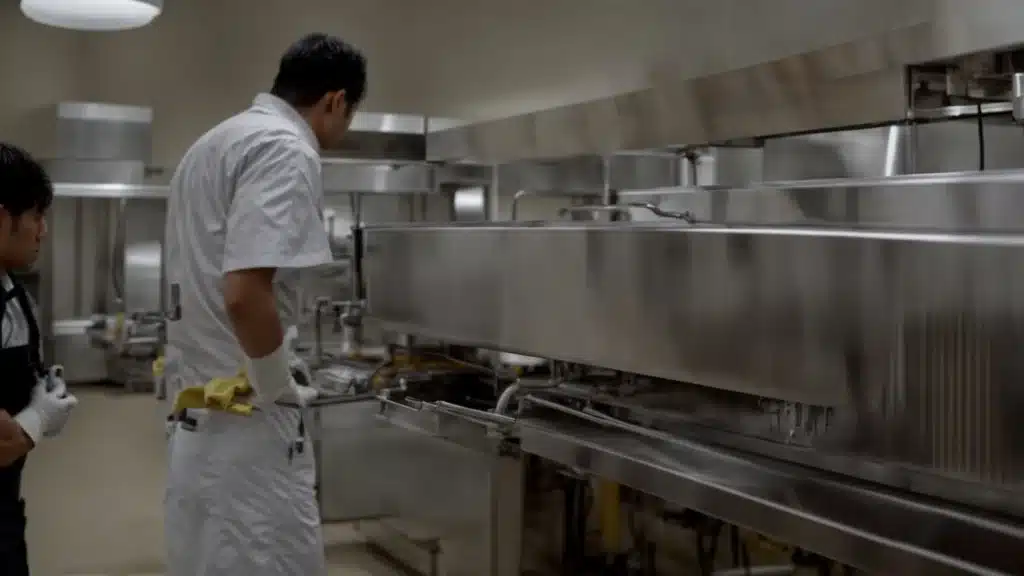Navigating the Cost-Benefit Analysis of Regular Hood and Kitchen Exhaust Cleaning
Amid the bustling kitchens of Ontario’s bustling culinary scene, the hum of cooking and clatter of dishes often drown out a critical chorus – the need for pristine hoods and exhaust systems.
Like heroes hidden in plain sight, these quiet guardians of fire safety and hygiene play a pivotal role in ensuring a restaurant’s heartbeats without interruption.
Yet, understanding the delicate dance between the investment in their upkeep and the manifold rewards it reaps can seem akin to navigating a maze blindfolded.
This article aims to illuminate the path through this labyrinth, arming you with the knowledge to embrace the clean air of success.
Keep reading to uncover the hidden benefits behind the grease, and how regular maintenance can be your kitchen’s unsung melody of efficiency and safety.
Key Takeaways
- Regular Hood and Kitchen Exhaust Cleaning Is Vital for Fire Safety, Regulatory Compliance, and Efficient Kitchen Operation
- initial and Ongoing Costs of Cleaning Must Be Carefully Weighed Against the Long-Term Financial and Safety Benefits
- Professional Cleaning Services Offer Thoroughness and Compliance, Potentially Saving Money in the Long Run Despite Initial Costs
- DIY Cleaning Strategies Carry Risks of Incomplete Cleaning and Safety Compromises, Which May Lead to Higher Costs Over Time
- Meticulous Documentation and Continuous Monitoring of Cleaning Practices Are Crucial for Maintaining Safety Standards and Optimizing Financial Investments
Understanding the Importance of Hood and Kitchen Exhaust Cleaning
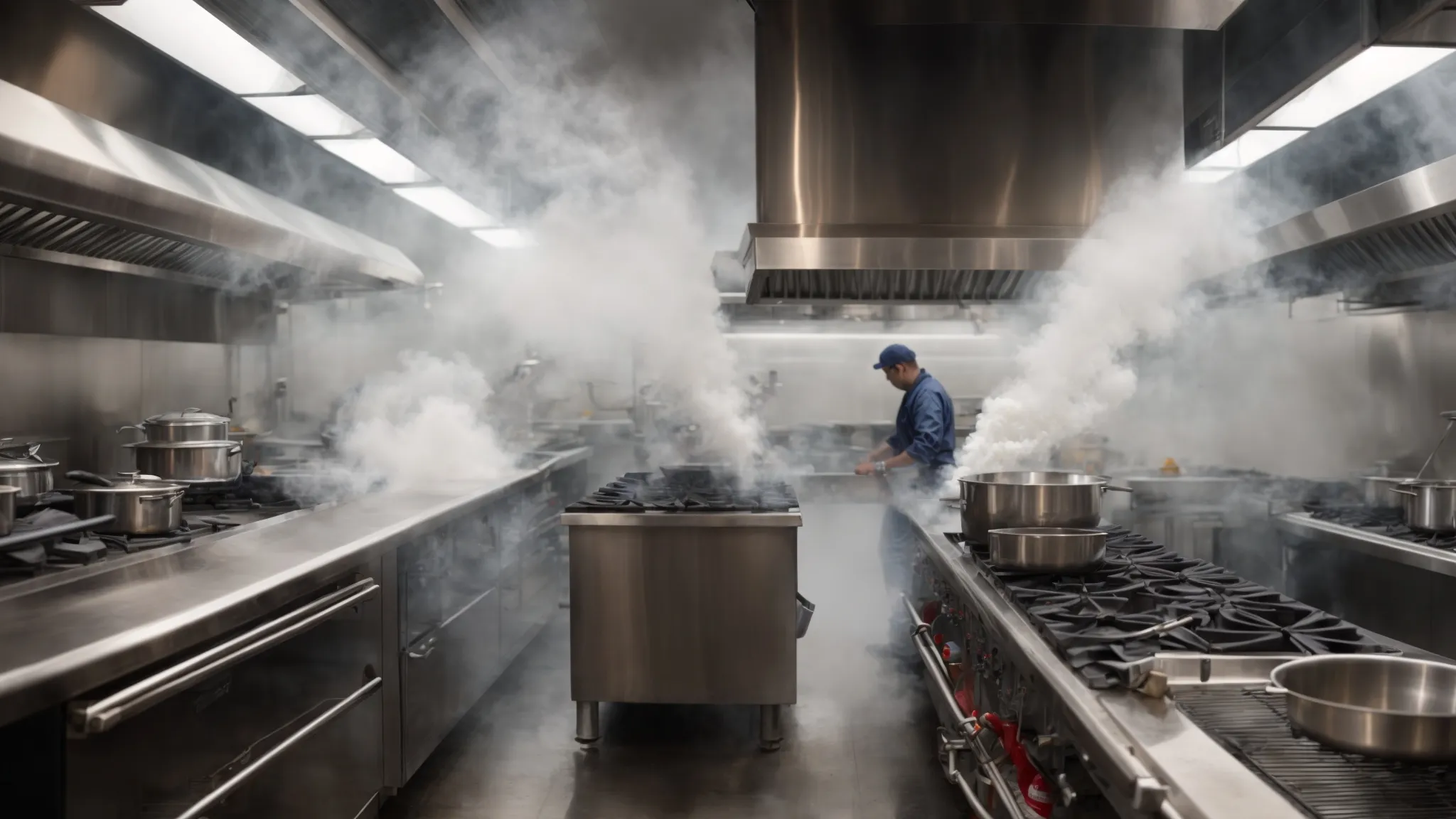
In the bustling hive of a commercial kitchen, the hood and exhaust system serve as the lungs, quietly drawing away the smoke and grease that are the inevitable byproducts of culinary creation.
Regular cleaning of these systems doesn’t just address the visible grime; it delves into the matrix of safety, health, and regulatory compliance, forming the backbone of any robust kitchen management strategy.
This necessity becomes starkly apparent when one considers the trifecta of concerns: the accumulation of hazardous contaminants, strict adherence to health and safety mandates, and the pivotal function of cleanliness in averting fire risks.
As each part is explained—including the constant need for careful maintenance, the strict framework of regulations, and the role of cleaning as a fire safety guard—it becomes clear that regularly cleaning kitchen hoods and exhaust ducts is more than just good hygiene; it is also an important defense against the many dangers that lurk in the invisible vapours of cooking processes.
Identifying the Need for Regular Cleaning
In the bustling ecosystem of a commercial kitchen, the silent but steady accumulation of grease and debris in the exhaust system is like a ticking time bomb, poised to ignite not only a fire hazard but also a regulatory nightmare. The need for regular cleaning, thus, becomes as clear as the daylight piercing through a grimy window, illuminating the urgency to maintain these systems for the sake of safety, compliance, and efficient kitchen operation.
Tracing the veins of a kitchen’s exhaust system reveals a hidden world where oil and particulates veil the inner workings, incrementally straining its function and turning up the dial on the risk of fire and contamination. Regular dismantling of this veil, a task championed by professional cleaners, is not a mere routine but a critical operation, ensuring the heart of the kitchen beats without a hitch, safeguarding dishes that emerge from its hearth against the backdrop of health and fire safety regulations.
Evaluating Health and Safety Regulations
In the labyrinth of commercial kitchen operations, navigating the thicket of health and safety regulations demands not just vigilance but a strategic mindset—one that recognizes the cost of compliance not as an expense, but as an investment in sustainability, customer satisfaction, and brand integrity. These regulations, often as diverse as the menus they protect, set the foundation upon which kitchen safety and public health precariously rest, a blueprint binding the fabric of culinary establishments across Canada, from Toronto to Calgary, and every bustling kitchen in between.
| Aspect | Regulatory Body | Key Regulation |
|---|---|---|
| Fire Safety | National Fire Protection Association | NFPA 96: Standard for Ventilation Control and Fire Protection |
| Health Standards | Local Health Departments | Food Premises Regulation under the Health Protection and Promotion Act |
| Environmental Compliance | Environment and Climate Change Canada | Canadian Environmental Protection Act, 1999 (CEPA 1999) |
Amid the simmering pots and sizzling pans, the importance of adhering to these statutes unfolds not just in the interest of avoiding penalties or citations, but in nurturing an atmosphere where safety and hygiene are paramount. Regulatory compliance, therefore, transcends mere legal obligation, morphing into a hallmark of excellence and an emblem of trust in the eyes of patrons, a tangible assurance that their welfare is the utmost priority alongside the culinary delights that grace their tables.
Recognizing the Role of Cleaning in Fire Prevention
Within the orchestration of flames and fervour that defines a commercial kitchen’s daily rhythm, the act of cleaning the hood and kitchen exhaust emerges as a critical refrain in the melody of fire prevention. This meticulous task extinguishes potential fire hazards through the removal of grease, a silent but highly flammable audience member in the grand opera of cooking.
The diligence of routine cleaning not only navigates through the nebulous threat of unforeseen flames but also harmonizes with the stringent symphonies of fire safety guidelines stipulated by the National Fire Protection Association. Acknowledging the role of cleaning in this context illuminates a pathway to a safer, more efficient kitchen environment: a realm where the specter of fire is banished by the vigilant guardianship of cleanliness and adherence to codes.
| Element | Impact on Fire Safety | Best Practice |
|---|---|---|
| Grease Accumulation | Increases Risk of Fire | Regular Cleaning and Degreasing |
| Ventilation Efficiency | Reduces Smoke and Heat | Ensuring Clear, Unobstructed Airways |
| Compliance with NFPA 96 | Meets Legal and Safety Standards | Adhering to Scheduled Inspections and Cleanings |
Now, let’s embark on a journey through the financial landscape of keeping your kitchen pristine. Prepare to unveil the balance sheet of cleanliness, where every dollar spent paves the path to safety and satisfaction.
Breaking Down the Costs of Regular Cleaning Services

Embarking on the journey of regular hood and kitchen exhaust cleaning entails a strategic analysis of the financial landscape, where the costs and benefits are meticulously weighed.
This road, while paved with the best intentions for health and safety, brings forth an array of financial considerations that extend beyond the surface of routine cleaning.
Initial estimates for deep cleaning services plant the seeds of investment, setting the stage for the subsequent, recurring expenses tied to maintenance that ensure the longevity and efficiency of the exhaust system.
Beyond the predictable, the terrain of this financial landscape is dotted with potential unforeseen costs, encompassing repairs and parts—an inevitable consequence of wear and tear.
Each element, from estimating the initial cleaning costs and calculating ongoing maintenance expenses to considering the additional costs for repairs and parts, contributes to a comprehensive understanding of the indispensable nature of this service, framing it within the context of a prudent financial commitment to the restaurant proprietors.
Estimating Initial Cleaning Costs
Embarking on the path of routine hood and kitchen exhaust cleaning initially involves deciphering the mosaic of costs entangled in the first foray into commercial kitchen deep cleaning: a crucial step before the canvas of longer-term maintenance unfolds. These initial costs, nebulous as morning fog in Toronto’s skyline, hinge on a multitude of factors: the size of the kitchen, the extent of grease accumulation, and the complexity of the exhaust system’s design.
- Assessing the square footage of the kitchen space and the corresponding exhaust system length sets the stage for initial estimates.
- Evaluating the level of grease and debris build-up points to the labor intensity required for thorough cleaning.
- Considering the specific requirements dictated by the system’s design, including access points and the type of cleaning technologies employed, refines the cost assessment.
The palette of initial cleaning costs, thus, is not a monochrome of fixed prices, but rather a spectrum influenced by these variables, crafting a narrative that restaurant owners must navigate with keen scrutiny. The consequent unveiling of initial costs serves as a foundation for a restaurant’s financial planning: a starting point from which the marathon of ongoing maintenance and the quest for kitchen safety and regulatory compliance begin.
Calculating Ongoing Maintenance Expenses
Once the initial veil of grease is lifted from the kitchen exhaust, the narrative shifts towards the sustained rhythm of ongoing maintenance expenses. These expenses are like the brushstrokes on a continuously evolving canvas, each session ensuring the functionality and safety of the kitchen’s respiratory system remain uncompromised, fostering an environment where culinary creativity can flourish unfettered by the threat of inefficiency or hazard.
The calculation of these maintenance expenses demands a thorough examination of frequency, the specific demands of the kitchen’s operational volume, and the evolving standards of regulatory compliance. As each kitchen sings a different culinary aria, the tempo of cleaning schedules and the detailed scrutiny required to adapt, ensuring that the harmony of cleanliness and safety resonates through the establishment, optimizing operational costs while steadfastly guarding against the shadows of potential risks.
Considering Additional Costs for Repairs and Parts
In the tapestry of regular hood and kitchen exhaust cleaning, the threads of unforeseen repairs and replacement parts weave through, adding layers to the financial fabric. This constellation of additional expenses emerges as kitchens age or when maintenance uncovers wear beyond the superficial grease and grime, necessitating a deeper intervention that often carries a higher price tag.
While the initial and ongoing costs chart the course of routine maintenance, it’s the surprise of sudden repair needs that tests the foresight and financial acumen of restaurant owners. Safeguarding against these unpredictable expenses involves not just a contingency fund but also a partnership with a cleaning service that excels in preventative maintenance, aiming to minimize the occasion and impact of these financial disturbances.
Shifting gears from the investment of cleanliness to its dividends, we uncover the hidden rewards of pristine exhaust systems. Strap in for an enlightening exploration of efficiency and safety reborn.
Analyzing the Benefits of Maintaining Clean Exhaust Systems

Peeling back the layers of expense associated with regular hood and kitchen exhaust cleaning unveils a spectrum of undeniable benefits, transcending mere compliance to foster a safer, more efficient, and sustainably operated culinary environment.
At the heart lies a triad of advantages: a significant enhancement of kitchen safety with a marked reduction in fire risks, an elevation in the quality of the working air through improved ventilation, and the promise of extended life for kitchen equipment.
Each benefit, intrinsic to the health of the restaurant’s very ecosystem, contributes not only to the physical well-being of the space and those within it but also to the financial health of the establishment, attenuating costs by preempting the consequences of neglect.
Enhancing Kitchen Safety and Reducing Fire Risks
The safeguarding of commercial kitchens from the spectre of fire emerges as a compelling testament to the value of regular exhaust and Hood Cleaning. By meticulously removing the buildup of grease—a notorious fire accelerant—the likelihood of hazardous flares is significantly diminished, encapsulating a fundamental principle: cleanliness serves not merely as a standard but as a guardian of safety.
This vigil in the face of potential disaster, spearheaded by professional cleaning services, ensures not only the integrity of the kitchen’s operational capacity but also protects the lives within it. The act of de-greasing and purifying the culinary arena from unseen threats transforms the environment into a bastion of safety, where the flame of culinary artistry burns bright, guided by the beacon of meticulous maintenance.
Improving Ventilation for a Healthier Work Environment
As the silent sentinel of a commercial kitchen, an efficiently functioning exhaust system plays a pivotal role in circulating fresh air, thus enhancing the overall air quality. This crucial improvement in ventilation, born from regular and thorough cleaning of the hood and exhaust, minimizes the presence of airborne contaminants, creating a healthier workplace for kitchen staff and a more comfortable dining atmosphere for patrons.
Moreover, this ventilatory rejuvenation, through its systematic reduction of smoke and unwanted odors, directly contributes to the enhancement of employee morale. Workers immersed in a cleaner, fresher environment are more likely to experience higher levels of job satisfaction, thereby positively impacting productivity and fostering a spirited atmosphere where culinary excellence thrives.
Prolonging the Lifespan of Kitchen Equipment
Embarking on a regime of regular hood and kitchen exhaust cleaning surfaces as a beacon of wisdom, it shines its light on the pathway toward longevity for kitchen equipment. This practice dislodges the gluttonous layer of grease and buildup, a hidden adversary to the mechanical harmony of ovens, stoves, and ventilation systems, thereby forestalling the wear and tear that creeps into kitchen life, silently shaving years off its vibrancy.
Such maintenance is more than a chore; it’s a pivotal investment in the heart of culinary enterprises. By ensuring that the arteries of kitchen equipment are free from the clutches of grease and debris, establishments secure a smoother operation, marked by fewer breakdowns and malfunctions. This vigilance not only holds the promise of extending equipment lifespan but also translates into significant cost savings on potential repairs and replacements, grounding the foundation of a financially healthy kitchen.
As we peel back the layers of pristine exhaust systems, a new horizon unfolds. Brace yourself as we juxtapose the expertise of professional cleaners with the rugged path of DIY ventures.
Comparing Professional Cleaning Services vs. DIY Approaches

In the woven tapestry of kitchen maintenance, where the threads of safety, efficiency, and compliance intertwine, the decision between engaging professional cleaning services and adopting a do-it-yourself (DIY) approach poses a critical crossroads.
This juncture demands a meticulous examination, where discerning the depth of cleanliness achievable, the allocation of invaluable time and resources, and the potential perils inherent in less experienced hands come into sharp focus.
Assessing the quality and thoroughness of professional services juxtaposed against the investment required for DIY methods, coupled with an understanding of the limitations and risks tied to the latter, orchestrates a comprehensive narrative.
It’s a tale that guides restaurant owners through the labyrinth of cost-benefit analysis, illuminating the path to informed, strategic decisions in the upkeep of their kitchen’s respiratory system.
Assessing the Quality and Thoroughness of Professional Services
In the realm of commercial kitchen maintenance, the depth of quality and thoroughness offered by professional cleaning services stand as a towering beacon of excellence. Such entities, equipped with an arsenal of specialized tools and seasoned expertise, delve into the very sinews of the hood and kitchen exhaust systems with precision and attentiveness, leaving no nook or cranny unattended.
Furthermore, these professional outfits navigate the complex web of regulatory compliances with ease, ensuring that each cleaning session not only meets but often surpasses the stringent standards set by health and safety authorities. This dual emphasis on meticulousness and adherence to regulations provides restaurant owners with a sense of confidence and security, knowing their kitchens operate within the safest parameters possible.
Evaluating the Time and Resource Investment in DIY Cleaning
In evaluating the approach of DIY cleaning, one must consider the significant allocation of time that diverts vital manpower away from core culinary and business activities. The process is not merely about applying elbow grease; it involves a meticulous understanding of the exhaust system’s anatomy, which can be a steep learning curve for those without specialized knowledge.
Further, the investment in resources for DIY cleaning transcends the purchase of cleaning solutions and equipment. Ensuring safety and effectiveness requires constant updates on regulatory compliance and potentially investing in technologies that professional services already possess and understand how to wield efficiently. This upfront and ongoing investment can cumulatively match or exceed the cost of enlisting professionals, without the same guarantee of thoroughness and compliance.
Understanding the Limitations and Risks of DIY Methods
Embarking on DIY approaches to hood and kitchen exhaust cleaning exposes one to the intricate dance of detail and danger inherent in the task. It requires a precision akin to that of an artist, where a single misstep could not only compromise cleanliness but also elevate the risk of fire hazards, all while navigating the tightrope of regulatory compliance without a safety net.
Without the seasoned expertise and specialized equipment possessed by professional cleaners, DIY enthusiasts might find themselves in a quagmire of inefficiency, where the efforts expended fail to meet the stringent standards set forth by health and safety regulations. This shortfall not only jeopardizes the regulatory standing of the establishment but can also lead to unforeseen expenses, overshadowing any initial savings envisioned.
The plot thickens as we transition from the DIY versus professional debate. Hold onto your hats; we’re diving into the often-turbulent waters of regulatory compliance and insurance implications!
Navigating Regulatory Compliance and Insurance Implications

In the intricate tapestry of kitchen maintenance, the thorny path of regulatory compliance weaves alongside the potentially rewarding avenues of insurance interactions, forming a critical juncture in the cost-benefit analysis of routine hood and kitchen exhaust cleaning.
This segment delves into the nuanced landscape of local and national safety regulations, appraises the interplay between insurance requirements and compliance discounts, and underscores the significance of meticulous documentation management.
As establishments navigate through the labyrinth of legalities and insurance implications, the objective remains clear: to emerge with a fortified stance that harmonizes operational integrity with financial prudence.
Unpacking Local and National Safety Regulations
Navigating the intricate domain of local and national safety regulations requires a keen understanding of the evolving statutes that govern the operations of commercial kitchens across Canada. These rules, reflecting the tapestry of Canadian jurisdictions, act as guiding principles that ensure the safety and health standards of food service establishments are consistently met and maintained.
| Level of Regulation | Concern | Key Regulatory Body |
|---|---|---|
| Local | Health and Safety, Environmental Standards | Municipal Health Departments, Fire Departments |
| National | Fire Safety and Prevention | National Fire Protection Association (NFPA) |
At the national level, compliance with the NFPA 96 standard—an encompassing guideline for vent hood and exhaust cleaning—stands as a critical requirement that aligns with fire safety measures. Adherence to these standards not only safeguards the establishment from potential hazards but also assures insurance providers of the establishment’s commitment to maintaining a safe environment, thereby potentially influencing insurance premiums and coverage terms.
Evaluating Insurance Requirements and Discounts for Compliance
Evaluating insurance requirements becomes pivotal as establishments consider the interplay between routine cleaning and the possibility of acquiring compliance-based discounts. Insurance companies often recognize the mitigation of risks through the regular hood and kitchen exhaust cleanings, potentially rewarding such vigilance with favorable policy terms or reduced premiums, acknowledging the proactive approach to fire safety and health standards.
Engaging in discussions with insurance providers about the direct relationship between adherence to NFPA 96 standards and insurance coverage can unveil opportunities for cost savings. This exploration not only underscores an establishment’s dedication to maintaining a safe working environment but also positions it to leverage its compliance measures as a negotiating tool, potentially securing financial benefits that offset the initial and ongoing investments in professional cleaning services.
Managing Documentation for Legal and Insurance Purposes
In the realm of safeguarding commercial kitchens from the myriad risks associated with fire and health hazards, meticulous management of documentation becomes a linchpin for both legal defense and insurance negotiations. Detailing every cleaning session with date, scope, and compliance adherence creates a robust audit trail, vital for demonstrating due diligence and operational integrity in the face of regulatory scrutiny and potential insurance claims.
This practice of scrupulous record-keeping not only fortifies an establishment against legal challenges but also positions it advantageously when brokering insurance terms. Armed with detailed historical data, restaurant owners can effectively negotiate lower premiums or more favorable coverage options, underpinning the financial prudence of their maintenance strategy:
- Gathering and organizing exhaustive records of each cleaning service performed – specifying the extent, frequency, and compliance details.
- Ensuring documentation is readily accessible and up-to-date, facilitating smooth reviews by inspectors, insurance adjusters, or legal advisors.
- Leveraging this compendium of diligence as a bargaining chip in insurance negotiations, potentially unlock cost savings and better terms.
Bridging the gap, we leap from the tangled webs of regulation and insurance challenges. The horizon promises savings, revealing the treasure of regular cleaning’s financial wisdom.
Long-Term Cost Savings of Regular Cleaning
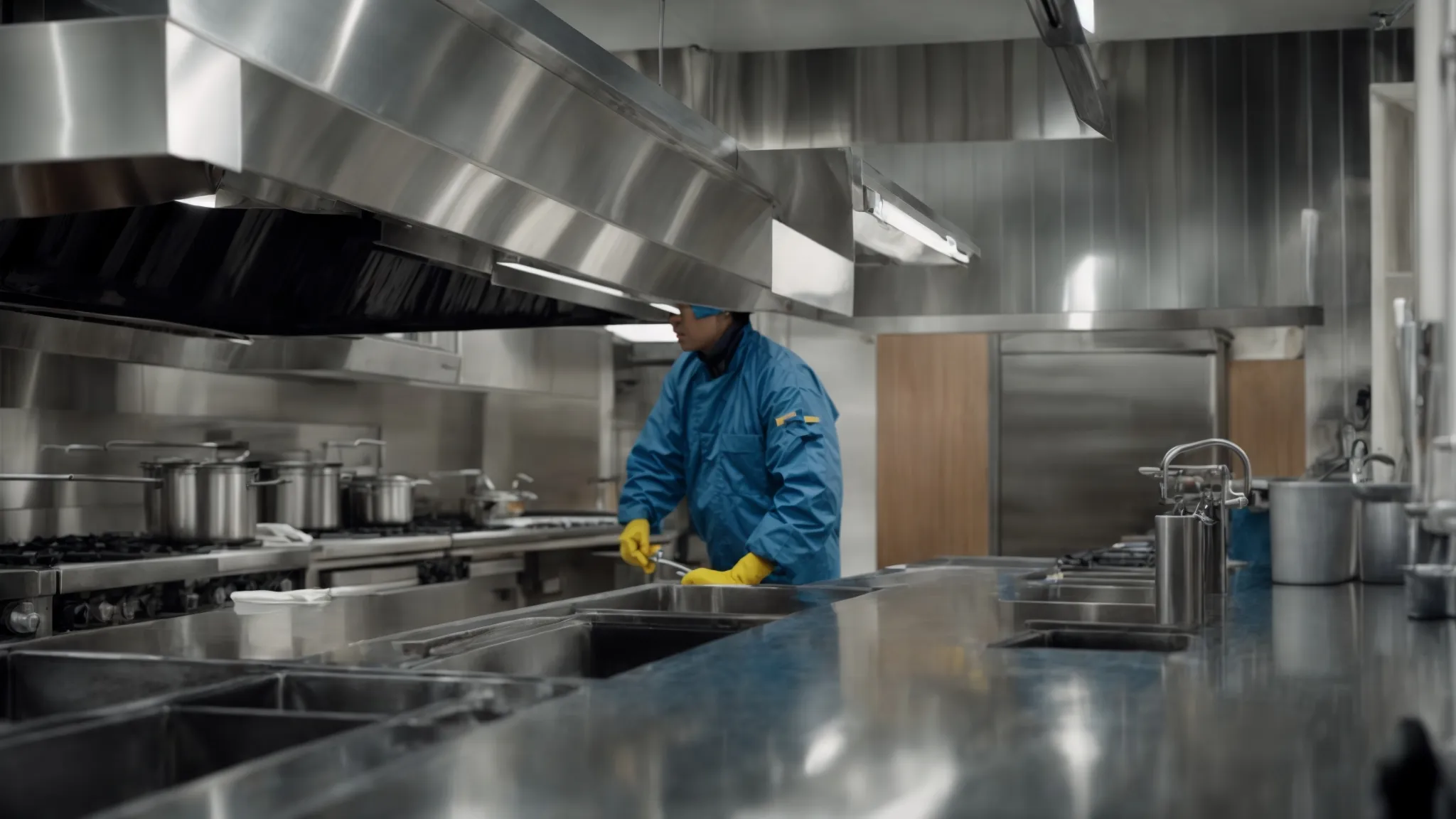
Delving into the realm of long-term cost savings, regular hood, and kitchen exhaust cleaning emerges as a prudent investment that mirrors the old adage, “A stitch in time saves nine.”
This journey through fiscal prudence navigates through avenues such as avoiding the financial burdens of costly repairs and replacements, the efficiency of reducing energy consumption alongside utility bills, and the intricate calculation of return on investment over time.
Each of these pathways offers a testament to the wisdom embedded in proactively maintaining the vital systems at the heart of commercial kitchens, underscoring the tangible benefits that extend far beyond the initial outlay.
Avoiding Costly Repairs and Replacements Through Maintenance
Embarking on routine maintenance for the hood and kitchen exhaust systems is akin to setting a vigilant watch against the encroachments of wear and tear that threaten the smooth operation of commercial kitchens. This commitment to regular cleaning forestalls the degradation that culminates in costly breakdowns, proving to be a strategic move that cushions restaurant owners against the financial shock of sudden repairs or the need for full replacements.
The meticulous attention to detail inherent in professional maintenance not only preserves the integrity of these essential systems but also adds years to their operational lifespan. By proactively addressing potential issues before they escalate, establishments circumvent the steep road to unexpected expenses, anchoring their financial planning on solid ground and ensuring uninterrupted kitchen functionality.
Reducing Energy Consumption and Lowering Utility Bills
In the intricate dance of maintaining a commercial kitchen, the act of regular hood and kitchen exhaust cleaning plays a pivotal role in reducing energy consumption. A clean system ensures that exhaust fans operate more efficiently, requiring less power to expel heat and airborne particles, which, in turn, translates to lower utility bills for the establishment.
This careful attention to exhaust cleanliness not only mitigates the risk of overheating and potential equipment failure but also contributes to an overall reduction in energy demand. As a result, restaurants can enjoy a harmonious balance between operational efficiency and cost-effectiveness, underscoring the profound impact of proactive maintenance on the establishment’s bottom line.
Calculating the Return on Investment Over Time
Embarking on a regimented schedule of the hood and kitchen exhaust cleaning transpires as an astute financial decision, pinpointing the space where initial outlays gently fade into the horizon of long-term financial gains. The formula for calculating the return on investment (ROI) interweaves reduced risk of fire hazards, enhanced efficiency of kitchen operations, and diminished need for costly repairs, eventually manifesting as a substantiated increase in savings over time.
Aligning the comprehensive care of exhaust systems with the principles of economic growth, the valuation of ROI extends beyond mere dollars. It encapsulates the preservation of equipment lifespan, conservation of energy, and reinforcement of safety standards, collectively building a financial shield that protects against the erosive costs of neglect. This strategic foresight into regular maintenance unlocks a panorama of fiscal health, turning the tide in favor of sustained economic stability within the bustling heart of a commercial kitchen.
The revelation of long-term cost savings paints only half the picture. A deeper exploration into cleaning frequency reveals an intricate tapestry of cost and benefit.
The Impact of Cleaning Frequency on Cost and Benefits
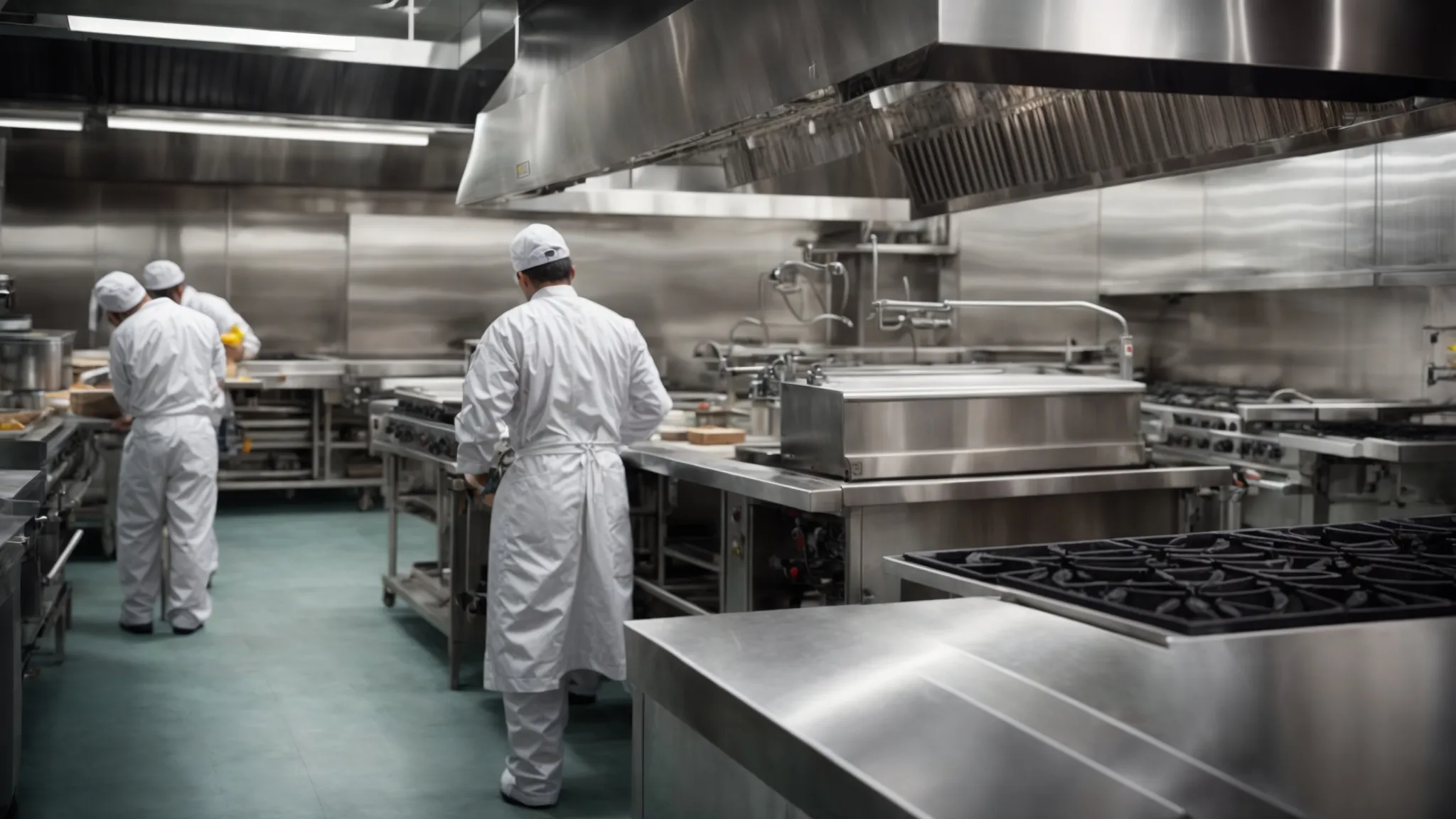
In the intricate choreography of managing a commercial kitchen, the frequency of hood and kitchen exhaust cleaning has a profound impact on both the fiscal and operational dynamics of an establishment.
Delicately threading through this matrix, restaurant owners are tasked with pinpointing the golden mean—a frequency that harmonizes the scales of cost-effectiveness, safety, and compliance.
This determination navigates through a spectrum of considerations, including the unique demands tied to a kitchen’s size and the intensity of its usage.
Embarking on this expedition reveals the multifaceted nature of optimal cleaning intervals, each dimension tailored to align with the intricacies of balancing expenditure against the invaluable dividends of maintaining a pristine, hazard-free environment.
Determining Optimal Cleaning Intervals for Your Kitchen
Determining the ideal intervals for hood and kitchen exhaust cleaning in your establishment hinges on an individualized assessment, where the intricacies of your kitchen’s operations set the tempo. Considerations such as the volume of cooking, the types of food prepared, and the layout of the exhaust system play pivotal roles in crafting a maintenance schedule that aligns with both safety standards and cost efficiency.
In charting the course toward establishing these optimal intervals, it becomes paramount for restaurant owners to engage with professional cleaning services. Their expertise offers a lens through which the nuances of grease accumulation and system wear can be discerned, enabling a tailored approach that maximizes the benefits while keeping a vigilant eye on the associated costs.
Balancing Cost-Effectiveness With Safety and Compliance
In the delicate dance of maintaining a commercial kitchen, finding an equilibrium between cost-effectiveness, safety, and regulatory compliance is paramount. This careful calibration acknowledges the financial realities of running a business while uncompromisingly adhering to standards that protect both workers and patrons from the latent dangers inherent in kitchen operations.
Engaging with professional cleaning services offers a route to navigate the often-complex landscape of health and safety legislation, ensuring that kitchens not only meet but exceed the requisite benchmarks. This strategic partnership transforms the necessary expense of hood and kitchen exhaust cleaning into an investment, safeguarding the establishment against potential penalties or damages, thereby promoting a culture of safety and compliance as cornerstones of culinary success.
Adjusting Plans Based on Kitchen Usage and Size
The dimensions of a kitchen and its gastronomic activities weave a unique tapestry, demanding bespoke strategies for the hood and kitchen exhaust cleaning. Smaller establishments, with less intense cooking schedules, might find a less frequent cleaning timetable sufficient, simultaneously preserving their fiscal resources while maintaining safety and compliance.
Conversely, larger operations with a heavier culinary workload—think bustling hotels or popular event venues—warrant a more rigorous approach to exhaust management. Here, the scale of kitchen usage not only justifies but necessitates a more frequent cleaning schedule, embedding efficiency, and safety within the matrix of operational costs and benefits.
Dive into the transformative tales of those who embraced routine upkeep. Witness the remarkable metamorphosis achieved through steadfast maintenance.
Case Studies: Success Stories of Regular Maintenance
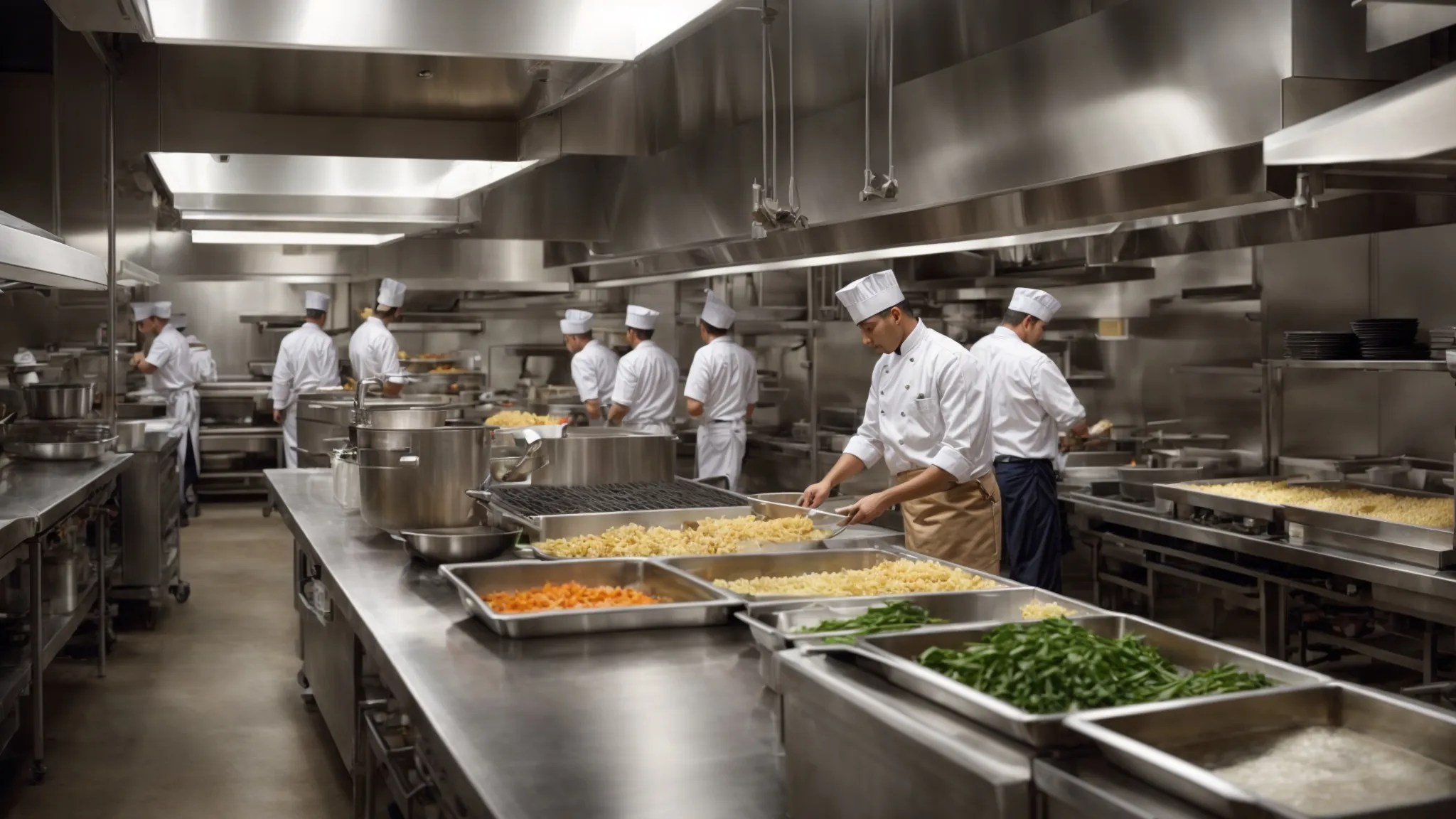
In the spirited journey towards mastering the intricacies of commercial kitchen maintenance, the tales of establishments that have successfully navigated the cost-benefit analysis of regular hood and kitchen exhaust cleaning shine as beacons of insight and inspiration.
By delving into real-world examples and analyzing the tangible outcomes of regular maintenance, this section aims to illuminate the discernible cost savings and remarkable improvements in safety records that have emerged from such diligence.
Furthermore, it seeks to distill the lessons learned and best practices adopted by industry leaders, offering a roadmap for others to enhance their kitchen’s operational efficiency and safety profile.
It is in these success stories that the true value and necessity of regular hood and kitchen exhaust cleaning are brought to vivid life, underscoring the indelible link between well-maintained kitchens and the flourishing establishments they support.
Highlighting Real-World Examples and Outcomes
In the heart of Toronto, a once-struggling restaurant saw remarkable improvements in operational efficiency and fire safety scores after partnering with Ontario Hood Cleaning for bi-monthly exhaust maintenance. This practical approach not only reduced their fire risk significantly but also cut down on their energy bills, showcasing the tangible benefits of consistent, professional exhaust system upkeep.
A case unfolding in Ottawa echoed a similar success narrative, where a renowned hotel chain experienced a reduction in kitchen-related insurance premiums by adhering to a strict schedule of hood and kitchen exhaust cleaning services. The meticulous documentation and adherence to NFPA standards presented during insurance reviews painted the establishment as a low-risk client, demonstrating the financial advantages of rigorous maintenance routines beyond immediate kitchen safety and compliance.
Analyzing Cost Savings and Improved Safety Records
A dive into the financial ledgers of establishments diligently engaging in regular hood and kitchen exhaust cleaning reveals a pattern of significant cost savings. These savings materialize through a reduction in the frequency and severity of repairs needed, a narrative supported by a reduction in energy consumption that directly enhances the profit margins of these culinary ventures.
Parallel to the financial benefits, an analysis of safety records post-implementation of routine cleaning regimens underscores a profound improvement in fire safety compliance and a notable decrease in incidents related to kitchen fires. This shift not only amplifies the reputation of the establishment as a safe dining venue but also fosters a work environment where staff can focus on culinary excellence free from the anxiety of potential hazards.
Drawing Lessons and Best Practices From Industry Leaders
Through the prism of industry leaders’ experience in the realm of commercial kitchen maintenance, a collective wisdom emerges, shining a light on the pivotal role of professional hood and kitchen exhaust cleaning services. They illustrate a profound understanding that investing in such maintenance is not merely an operational cost but a strategic maneuver that enhances safety, efficiency, and ultimately, profitability.
Observing the practices adopted by these pioneers reveals a common thread: the integration of regular, thorough cleaning schedules with the latest in cleaning technology and methodology. This approach not only keeps their establishments compliant with the stringent standards of health and fire safety but also positions them as paragons of culinary hygiene, setting a benchmark for excellence in the industry.
The narrative unfolds, revealing the compelling triumphs of routine upkeep. With anticipation, we pivot towards arming you with strategies for mastering your own cost-benefit analysis.
Tools and Resources for Conducting Your Own Cost-Benefit Analysis

In embarking upon the meticulous journey of dissecting the intricacies of the regular hood and kitchen exhaust cleaning, one venture into a realm best navigated with precision tools and fundamental methodologies at the ready.
This essential analysis, pivotal for the strategic foresight of commercial kitchen operations, demands a structured approach, underscoring the importance of resourceful tools and clear, implementable guidelines.
Herein, we delve into the introduction of key concepts foundational to conducting a thorough cost-benefit analysis, spotlighting tailored software and digital aides designed for such evaluations.
Furthermore, the provision of templates and checklists emerges as a beacon, guiding establishments through the procedural steps with ease and efficiency, ensuring that every pivotal aspect of the analysis is meticulously addressed and seamlessly integrated into operational planning.
Introducing Key Concepts and Methodologies
Embarking upon the refined pathway of cost-benefit analysis for the regular hood and kitchen exhaust cleaning invites the exploration of methodologies that dissect the intricate balance between outlays and advantages. This pursuit necessitates an acquaintance with economic principles like return on investment (ROI) and total cost of ownership (TCO), which serve as cornerstones for evaluating the economic footprint of maintenance strategies.
Understanding the dynamics of these methodologies allows restaurant owners to pierce through the veil of initial costs, unveiling the long-term benefits that span across enhanced safety, regulatory compliance, and operational efficiency. It transforms the analysis from a mere number-crunching exercise to an insightful expedition, charting a course toward informed decision-making in the realm of kitchen maintenance.
Listing Tools and Software for Analysis
In the digital era, specialized software and analysis tools have emerged as invaluable allies in simplifying the cost-benefit analysis of regular hood and kitchen exhaust cleaning. Applications such as CostBenefitAnalysisTemplate.net offer a user-friendly platform, enabling restaurant owners to input data and receive clear, comprehensive insights into the financial implications of their maintenance decisions.
Additionally, platforms like CleanMetrics embody cutting-edge technology, integrating environmental and economic variables to provide a holistic view of the cost-effectiveness of cleaning practices. These tools not only facilitate a nuanced understanding of the expenses and savings involved but also empower business owners to make informed choices based on empirical data and projections.
Offering Templates and Checklists for Easy Implementation
In the intricate journey towards mastering the cost-benefit analysis of regular hood and kitchen exhaust cleaning, the availability of templates and checklists plays an instrumental role in streamlining the process. These resources, meticulously crafted to encapsulate every pertinent aspect, empower restaurant owners to seamlessly transition their analysis from a conceptual framework into actionable insights.
Adopting these tools imbues the analytical process with both structure and clarity, allowing for a systematic evaluation of costs against the tangible benefits. By leveraging templates and checklists, establishments carve a path through the complexity of decision-making, ensuring that every critical element is considered, thereby enhancing the precision and reliability of their cost-benefit analysis endeavors.
Equipped with the right tools and insights, the stage is set. Unveiling the optimal cleaning strategy becomes the thrilling next act.
Making an Informed Decision on Your Cleaning Strategy

Navigating the intricacies of regular hood and kitchen exhaust cleaning requires a comprehensive understanding of its economic and safety implications.
In this crucial juncture of kitchen maintenance, restaurant owners and facility managers face the challenge of deciphering the most cost-efficient and effective path forward.
This section delves into the nuanced pros and cons of various cleaning strategies, paving the way for informed decisions.
Through a step-by-step guide, it aims to simplify the complexity of this decision-making process, subsequently offering pragmatic recommendations for seamless implementation and diligent monitoring of the chosen cleaning regimen.
Each approach is scrutinized not just for its immediate impact, but for its long-term contribution to the establishment’s operational excellence and adherence to health and safety standards.
Summarizing Pros and Cons of Various Approaches
Embarking on the strategic path of regular hood and kitchen exhaust cleaning unravels a tableau of methodologies, each with its distinct advantages and limitations. The professional cleaning service approach stands as a bastion of thoroughness, leveraging specialized equipment and expertise to meet high standards of cleanliness and compliance, yet it requires a financial commitment that might strain tight budgets.
In contrast, the do-it-yourself (DIY) strategy offers cost savings upfront, appealing to those keen to minimize expenses. However, this route carries the risk of incomplete cleaning due to lack of specialized tools and expertise, potentially leading to higher long-term costs from unaddressed issues, and compromises in safety and regulatory adherence.
Providing a Step-by-Step Guide for Decision Making
Diving into the cost-benefit analysis of regular hood and kitchen exhaust cleaning begins with a meticulous assessment: a step-by-step guide crystallizes the pathway to an informed decision. This process demands an examination of current kitchen practices, evaluating the extent of grease accumulation and the efficiency of existing cleaning routines.
- Identify the current state of the kitchen exhaust system and benchmark it against industry standards for cleanliness and safety.
- Consult with professional cleaning services to gain insights into the latest cleaning technologies and methodologies, understanding their costs and benefits.
- Analyze the kitchen’s operational demands and determine the frequency of cleaning required to maintain optimal safety and efficiency.
- Estimate the initial and ongoing costs associated with both professional services and DIY strategies, integrating insights into the broader financial framework of the kitchen’s operations.
- Consider the potential savings in terms of energy efficiency, fire safety compliance, and equipment longevity versus the upfront and recurring expenses of cleaning services.
- Make a decision based on a balanced assessment of financial outlay, operational efficiency, safety standards, and regulatory compliance.
Armed with this structured approach, restaurant owners can navigate the dense forest of decision-making with clarity, aligning their cleaning strategy with both the kitchen’s operational needs and financial realities. This step-by-step guide offers not just a route to compliance and safety, but a strategic framework for enhancing the overall efficiency and profitability of the culinary enterprise.
Recommending Next Steps for Implementation and Monitoring
Embarking on the pathway of routine hood and kitchen exhaust cleaning, the initial step involves securing a professional service partnership that aligns with the establishment’s operational and financial objectives. This crucial selection, marked by thorough vetting of credentials and services offered, sets the stage for a symbiotic relationship geared towards maintaining optimal kitchen safety and efficiency.
Upon establishing this foundational alliance, the focus shifts towards a rigorous regimen of monitoring and evaluation. Maintenance sessions must be meticulously documented, with each cleaning episode detailed for scope, compliance alignment, and effectiveness, thereby ensuring a continuous alignment with health and safety standards while optimizing the financial investment in cleaning services.

